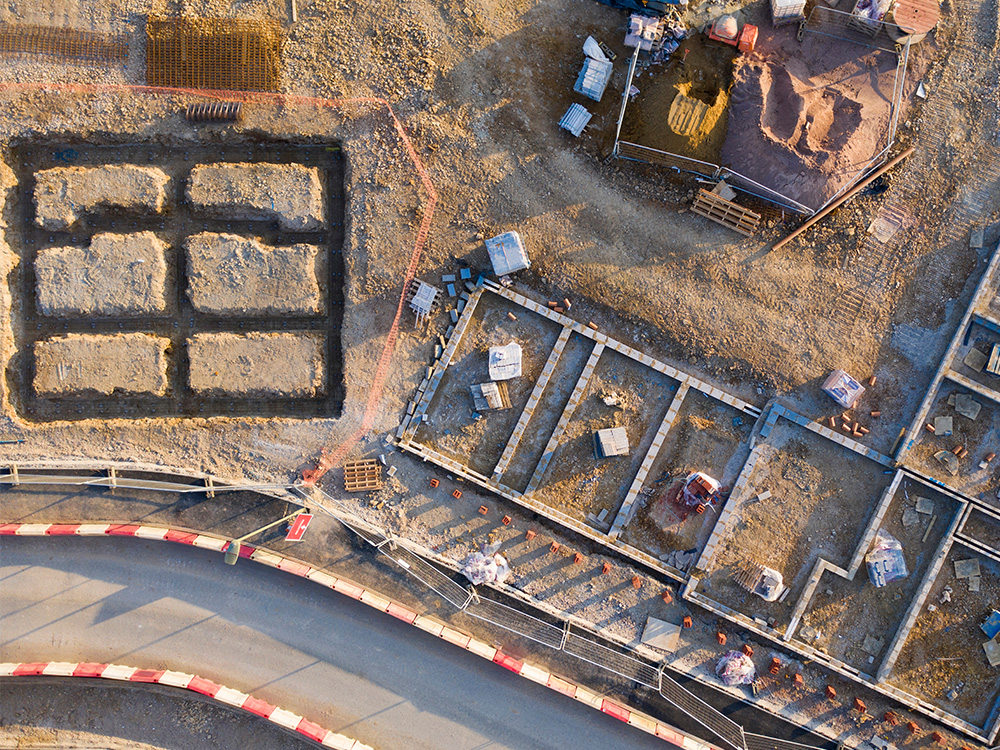On this page
Bridging loan for property development The 4 most common development scenarios Is property development still profitable? What kind of property conversions can a bridging loan finance? What's the difference between a bridging loan Vs property development finance? What is a bridging loan? What can a bridging loan be used for? Can I use a bridging loan to develop a commercial property? How to get a property development bridge loan? Compare bridging loans for property development What costs are involved in taking out a bridge loan? Can you use bridging loans to acquire a site? How much can you borrow with a bridging loan? Can a bridging loan be taken out in the name of a limited company? Bridging loans for development FAQsBridging loan for property development
Bridging loans are a versatile financial tool that can be used to make self-builders, developers and investors money, and by and large the most frequent use of a bridging loan is for property development.

The 4 most common development scenarios
Seeking to raise funds for development? Require a short term finance solution in just a few days? The answer could well be a short term bridging loan. This article reviews the 4 most common development scenarios in the UK where bridging loans are used, why they're used, their benefits and helpful tips when sourcing bridging loan lenders. These four scenarios are:
- Property renovation
- Property conversion
- Property refurbishment
- Ground-up property development
So, first off, a quick overview of how these four scenarios are different. Whilst terminology is key, they all have the same purpose which is to increase the property value.
Property renovation: Typically refers to work that involves restoring a property to a former better state than its current state. When it comes to bridging loans we usually refer to property renovation when the work required is more than a light cosmetic touch and there's heavier structural work involved, for example, knocking out walls, extending the property, replacing roofs and such. Find out how much your renovation may increase your property value.
Property conversion: Typically used to describe a change of use from non-residential to residential for example, a barn conversion, church conversion, or other building types.
Property refurbishment: Typically used to describe a light-touch approach to an existing property, for example: installing a new kitchen, bathrooms, plumbing or central heating installations, redecoration and so on. The term refurbishment wouldn't usually be used to describe major works such as renovation that may include structural works.
Ground-up property development: Refers to a completely new build of property, usually on a new site which hasn't been previously built upon or one that has been cleared. Unlike the three previous types of property development, this type of development normally requires funding via 'property development finance' as opposed to a traditional 'bridging loan'.
Is property development still profitable?
Property development, like anything worthwhile, is not easy, especially for first-time developers, however it can be profitable for those who learn how to avoid the pitfalls. Once you've mastered the process, you'll be able to better prepare and anticipate potential obstacles on the next project allowing you to focus on increasing your profits.
What kind of property conversions can a bridging loan finance?
It's not just barns that get converted! Here's a list of interesting possibilities that have all been converted into residential dwellings in the UK.
- Forts
- Public toilets (even underground public toilets)
- Water towers
- Carriage houses
- Stables
- Courthouses
- Train stations
- Schoolhouses
- Car repair shops
- Grain silos
- Banks
- Airbase control towers
- Churches
- Firestations
- Lifeboat stations
- As well as barns, of course
What's the difference between a bridging loan Vs property development finance?
Really simply, a bridging loan is short-term finance, usually no more than 12 months, though it can be up to 24 months. It's drawn as a single lump sum loan, there are typically no monthly payments and the loan is then repaid in full in a single lump sum when the term ends.
The primary difference between this and property development finance (also known as a development loan or simply just development finance) is that it is not drawn in a single lump sum but staged to be drawn as and when the development schedule requires it.
As new-build construction takes longer than simple refurbishments or renovations, this approach of draw down means the interest paid on the loan is minimised as only the essential funds are drawn as and when it is needed. It is very effective with larger property development projects but is often too complicated for smaller projects. Renovating properties or small conversion projects can be better funded through a bridge loan.
What is a bridging loan?
Bridging loans are loans that are usually taken, as their name suggests, to bridge a gap in funding. They are also referred to as bridge loans, bridging finance or bridge finance.
When used specifically for property development a bridging loan is usually secured against the property the borrower is taking the loan to renovate, refurbish or convert. However, the bridging loan can also be secured entirely on another property or group of properties the borrower owns.
Essentially the lender requires the borrower to offer property as security, which is also known as collateral and that security must be of high enough value to cover the loan and any associated charges, fees and interest due.
Most bridging finance solutions are considered a 'closed bridging loan' as they usually have a defined term at which point they are to be repaid and will have had a defined exit strategy detailed from the outset.
Need more information: Please read our full bridging loan guide.
What can a bridging loan be used for?
A bridging loan can be used for:
- the purchase of land
- the purchase of the property; and or
- the works involved in refurbishing, renovating or converting the property into a habitable dwelling; and or
- providing financial support between the sale of a development and the acquisition of the next development.
Can I use a bridging loan to develop a commercial property?
Yes, you can use bridging finance to either acquire or develop commercial property.
How to get a property development bridge loan?
Knowing some basics about how the process works will increase your chances of obtaining a bridging loan - especially for property development as lenders prefer to lend to experienced property developers.
Coming equipped with all the correct up to date information and answers will not only help position you as experienced, avoiding common pitfalls and mistakes, but it will also expedite the whole process. You can read more about what to expect and how to speed up the process of obtaining a bridging loan.
Compare bridging loans for property development
We believe that to obtain the best bridging finance deal possible for your specific circumstances you need to find more than one lender who wants the deal. Creating a competitive marketplace for your loan allows you to achieve the best value and obtain the best terms.
Bridging brokers who may have access to multiple lenders that may include specialist lenders, family offices, private investors as well as the 150 regular high street lenders, and are often best placed to source the right lenders for specific loan applications.
Bearing in mind, not all lenders will like every deal put in front of them, it's no small task knowing who to choose for your specific needs, and how to position it to each lender to make it most attractive.
This is our raison d'être - we're a bridging broker and we believe bridging loans should either make you money or save you money. If you want to know more about bridging loan brokers then read our article 'What is a bridging loan broker?'
What costs are involved in taking out a bridge loan?
The typical costs for a bridge loan may include some or all of the following:
- Interest rates
The interest rates on short term finance such as bridge finance are more expensive than traditional mortgages available from traditional lenders. Interest is often calculated monthly, not annually, and typical interest rates range between 0.5% to 2% per month but may be lower for significantly larger loan values or where the LTV or LTGDV is low. - Broker fee
If you're using a broker like Finbri, broker fees pay for our work in understanding your case, presenting your case to our specialist lenders, assisting with the loan application, reviewing the bridging loans or development finance options for you and sourcing the best solution for you. Typically a broker fee is 2% of the total loan. - Arrangement fee (also known as facility fee)
This is paid to the lender for arranging the loan facility, typically it's 2% of the total amount loaned but may vary from provider to provider. - Valuation fee
This is the fee paid to the valuer who will visit the site to assess the property value, otherwise known as its open market value. - Administration fee
This is to pay for the administration of the loan from application through to completion and typically costs no more than £500 in total. - Redemption fee
This fee is specifically for work such as removing a charge over an asset typically £200 or so depending on the lender. - Solicitor fee
For obvious reasons, lenders use solicitors when arranging and securing a charge over a property. This fee for drawing up legally binding contracts etc is always charged to the borrower.
Can you use bridging loans to acquire a site?
Yes, you can use a bridging loan to purchase a new site as:
- land in order to obtain planning, or
- land with planning, or a
- site with structures already upon it.
How much can you borrow with a bridging loan?
The maximum loan amount varies largely on many variables but the main factors include the purpose of the credit, what type of planning permission the project has, how much the security is valued at and how much equity is available in the security offered.
Here's an approximate indication of maximum values depending on their use in development scenarios:
- Bridging loan for purchasing land with planning permission
- maximum loan-to-value (LTV) will be up to 70% - Bridging loan for purchasing land without planning permission
- maximum loan-to-value (LTV) will be up to 50% - Bridging loan for purchasing residential property
- maximum loan-to-value (LTV) will be up to 80% - In all cases, up to 100% can usually be borrowed where the borrower is able to offer additional properties as security.
- Bridging loans for development, refurbishment & renovations
- maximum loan-to-gross-development-value (LTGDV) will be up to 65% - 100% Build financing is typically available
- Joint Venture (JV) is typically available
- 100% structured finance is typically available
Find out what you could borrow on your project here.
Additional requirements of a bridging loan for property development
Aside from the project particulars and the security being offered, lenders may also examine your past work in property development, evaluating your successes and failures including whether or not previous loans for property development were repaid on time. Bridging lenders want to know they can trust you so always be straight with your answers.
Can a bridging loan be taken out in the name of a limited company?
You can apply for a bridge loan via any legally recognised UK entity such as a Limited company or individual. In addition, loans may also be lent to foreign nationals and offshore companies in situations where appropriate due diligence is possible.
Bridging loans for development FAQs
How can bridging loans help property developers?
When developers require a short term loan to raise capital for construction projects, bridging loans are available for the purchase or renovation of sites.
When is a bridging loan repaid?
This loan is usually designed to be repaid at the end of the term via sale or refinancing.
What is bridging loan debt secured on?
In short, property. Both bridging finance and development finance can be secured on residential, commercial properties or even mixed-use. It can also be secured on land with or without planning permission.
Will banks lend to property developers?
There are only a very limited number of high street banks who now offer bridging loans to developers and even fewer to 1st-time developers.
What is an uninhabitable property?
An uninhabitable property is a dwelling that is so damaged or lacking in basic amenities that it is not liveable. This can be due to many reasons, such as severe weather damage, fire, or even poor construction.
Want to ask us a question about how to finance your next property development project? No problem, we'll call you right back - just schedule a call with our bridging and development specialists.
Development Finance
We arrange finance for both experienced and first time developers for land purchase, ground up development, mixed-use schemes & heavy renovations.
Discover More




